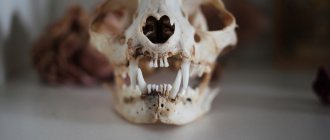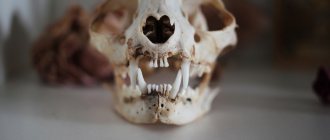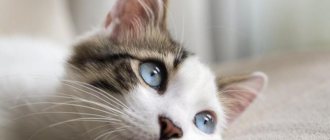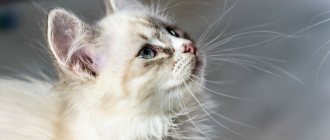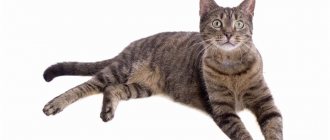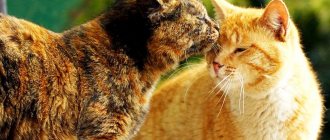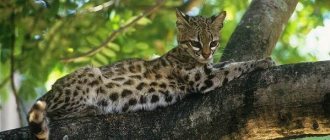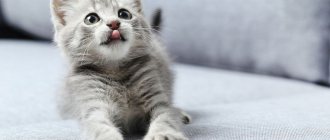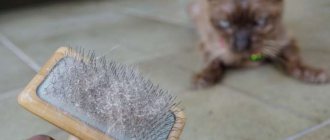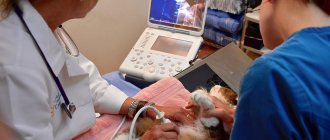Features of the structure of cats
Cats became pets much later than dogs. Therefore, they retained the body structure characteristic of all representatives of the cat family. The length of the body of a domestic cat varies within 60 cm, and the length of the tail is 25–30 cm. The average weight of a cat is 2.5–6.5 kg, but there are also impressive specimens weighing 7–9 kg. And cats of the Siberian and Maine Coon breeds can weigh 11–13 kg. There have been cases when cats reached 20 kg, but most often the reason for this was obesity.
On average, cats weigh up to 6.5 kg, but Maine Coons and Siberians can reach a weight of 13 kg
There are 4 parts of a cat's body:
- Head. It distinguishes between the brain (cat's skull) and facial (muzzle) parts. The front part also includes the forehead, nose, ears, and teeth.
- Neck. Here the upper part and the lower region are distinguished.
- Torso. It is represented by the withers (it is formed by the first five thoracic vertebrae and the upper edges of the scapula, which are on the same level with them), back, lower back, thoracic region (chest), croup, inguinal, abdomen, area of the mammary glands and prepuce, anal region, tail.
- Limbs. Thoracic (front): shoulder, elbow, forearm, wrist, metacarpus and pelvic (posterior): thigh, knee, shin, heel, metatarsus.
Features of the external structure of cats
On average, the length of an adult cat excluding the tail is 50-60 cm, with the tail - 75-85 cm. Sexual dimorphism is weak - females are only 5-7 cm smaller than males. The height of cats at the withers is 25-28 cm.
The largest cat, according to the Guinness Book of Records, is a Maine Coon from Melbourne named Omar, its length is 121.9 cm.
A pet weighs on average from 2.5 to 6.5 kg, but there are breeds whose representatives are considered real heavyweights. For example, the jungle cat, Siberian cat and Maine Coon can gain weight up to 13 kg.
Head
Cats have an elongated or rounded head. Relative to the entire body, it is small in size. For example, wild relatives like the tiger and lion have a larger muzzle due to a more massive jaw and pronounced fangs.
The surface pattern of a cat's nose is unique, like a human fingerprint.
The cat can rightfully be called a big-eyed animal. And it's not just a matter of keen eyesight. Cats are among the ten animals with the largest eye sizes relative to the size of their muzzle. Thanks to this feature, cats can immediately see a picture with a 200° field of view without moving their head (for comparison, a person’s visual range is only 180°).
Each cat’s ear is controlled by more than 10 muscles, thanks to which cats can change the position of the ears on the head - press them, bend them, turn them towards the sound, etc.
A special feature of the cat is the presence of very sensitive whiskers on its face. These are hard whiskers, which at the base are penetrated by a large number of nerve endings. Under no circumstances should you pull, let alone tear out, these whiskers - this causes pain to the animal.
With the help of whiskers, the cat receives information about everything that surrounds him - about objects, about the weather, approaching enemies and even the temperature of food
Torso
The body of a cat is divided into the back, chest, and abdomen. According to the relationship of the body to the head and paws, cats have three body types:
- Heavy - these cats have a wide body, a large head and rather short but dense legs and tail.
- Lungs - the body is slender and elongated, the head seems miniature in comparison.
- Medium - in this case, there is maximum harmony between the sizes of the body, head and tail. As a rule, outbred animals have an average body type.
Hair coat is of great importance for a cat. There are no wild naked cats (sphynxes are the result of artificial selection, they are not able to survive in nature). Wool protects the animal from cold, direct rays of the sun, and injuries. Miniature muscles located at the roots of the hairs can raise them on end - at such moments, cats seem larger than usual. This is a defense mechanism designed to scare off the enemy.
Cats love to climb higher - their long tail allows them to maintain balance.
Limbs
Some people mistakenly consider only the pads on which the animal steps when walking and running to be a cat's foot. In fact, it is longer and reaches a protuberance that is a vestigial finger (it can be easily felt, since the claw never retracts into it). It turns out that the cat moves “on tiptoe” all the time.
The photo shows that cats have five fingers - 4 on one side of the pad and one, rudimentary, located away from their “comrades”, on the opposite side
The structure of a cat's skeleton and its joints
The skeleton plays the role of a frame made of bones (a cat has about 240 of them) and has 2 sections: axial and peripheral.
The skeleton of a cat has about 240 bones
The axial section includes:
- The spine consists of 30 vertebrae, which are divided into 5 sections. The cervical vertebrae are large and allow the cat to turn its head almost 180 degrees without changing body position. The tail also belongs to the spine; it allows you to maintain good balance when jumping and falling.
The tail is part of the spine and helps maintain balance.
- The chest consists of 12 pairs of ribs.
- Cat skull. Unlike other mammals, cats have a short skull, and the size of the head in relation to the size of the entire body is small. Conventionally, the skull can be divided into 2 parts:
- facial, on which 13 bones are located;
- cranial, which contains 11 bones. The bones of the skull are stronger and larger than the facial part. The cat has a powerful jaw. Its main attribute is teeth. An adult animal has 30 of them. But even a kitten at the age of 3-4 weeks already has 26 sharp teeth. At 5–6 months, complete replacement of baby teeth with molars occurs.
Cats have shorter skulls than other mammals
The peripheral section includes the fore and hind limbs.
We all know that cats walk as if “on their toes”, without stepping on their heels completely. This is explained by the fact that the knee is located higher than we usually think - near the stomach.
There are 5 toes on each of the front paws, and 4 on the hind paws. Each toe ends in a sharp claw, hidden in a so-called pouch when at rest.
The cat only releases its claws when necessary.
Cat joints are divided into:
- sutures that form between the fused bones of the skull and consist of hard fibers, devoid of mobility;
- cartilaginous, which consist of durable cartilage; in cats, these compounds are more flexible and mobile than in other animals;
- synovial - these are connections between two or more bones, providing them with greater mobility, the main types of such connections: spherical,
- articulated.
Video: cat skeleton
Hind limbs of the skeleton
When it comes to the structure of a cat's skeleton, it is important to pay special attention to the hind limbs, which consist of the pelvis
(right and left innominate bones),
thigh
(consists of the femur and patella),
lower leg
(includes the fibula and tibia) and
foot
(it includes the tarsus, metatarsus and 4 phalanges of the fingers). By the way, some cats may have 5 toe phalanges on their hind legs.
The hind limbs of the cat are powerful, moderately long and excellently developed. They allow the cat to climb trees and jump high without any problems. It is believed that on average a cat can jump to a height that is 5 times its height.
.
Also, the massive hind limbs allow the mustachioed pets to run quickly. In case of danger, cats can reach speeds of about 45 kilometers per hour
. For comparison: only some sprinters can reach this speed, but the average person can run at a speed of only 15 (maximum 20) kilometers per hour. But a cat can outperform even any fast runner, because a person can only walk or run on a horizontal surface, while a cat can overcome vertical obstacles.
Muscular system
Cats have an unusually developed muscular system. This is proven by their amazing jumps over fairly long distances and fast running. Also, a set of muscles helps the cat maintain its aristocratic bearing.
Thanks to its developed muscular system, a cat is able to perform amazing movements.
In total, a cat has about 500 muscles. They can be divided into 3 categories:
- heart muscle;
- smooth muscles, which control internal organs and work involuntarily;
- striated muscles that the cat controls itself.
Special fibers are part of all muscles. Cat muscles contain 3 types of cells:
- are strongly contracted, but work for a short time - thanks to them, the cat is able to jump long distances; the strength of these cells is not able to act for long;
- with a strong contraction they work for a long time - a cat has few such cells, which explains its inability to run long distances;
- they contract quietly and work for a long time - this type of muscle cells is used in a cat when hunting, when it sits in ambush for a long time, and also sneaks quietly and gently.
When hunting, a cat uses muscle cells that can work for a long time
The structure of the shoulder girdle has a peculiarity: the muscles connect the forelimbs and the torso, while in humans they are connected by the collarbone. In cats it is in its infancy.
To take a step, the cat pushes off with its hind paws, and the front paws participate in the braking process. Thanks to the elasticity of the back muscles, the cat can easily curl into a ball and assume other bizarre poses.
X-ray of a cat
X-rays are prescribed for cats in different cases; it can be either emergency or planned. The study helps diagnose:
- Injuries to the limbs and skull.
- The presence of foreign objects in the body.
- Damage to the chest.
- Pneumonia.
- Pregnancy and the location of kittens in the uterus.
- Jaw pathologies.
- Anomalies of the heart and lungs.
- Formed metastases and other neoplasms.
X-ray of a cat
How to prepare your pet for x-rays?
Cats are always stressed during transportation, so they may arrive for x-rays very anxious. In this case, you can use the drug Kot Bayun, it has an excellent mild calming and sedative effect.
If you live in a large city, you can call a doctor with a mobile x-ray machine.
How is the procedure done?
Cats are not able to sit quietly in a certain position, much less in an unfamiliar room. Therefore, several specialists help take an x-ray. They fix the cat in the desired position, in this case the photo is of high quality. And then you can find pathologies on it or make sure that your cat is completely healthy.
Many cat owners are interested in this question: is x-ray dangerous for cats? Currently, only high-quality devices are used that comply with global health regulations. Therefore, the X-ray procedure will not harm your pet. The only thing I would like to note is that you must understand that radiation is not useful in any case, and there is no need to take pictures several times a month.
If you carefully read the article, then now you know how your pet’s body works. And now you understand that fluffy and cute creatures are actually agile and fast predators. And you shouldn’t be surprised that your pet asks for meat and also looks with surprise at the vegetables offered to him. Read also about anatomy.
Leather and wool
The skin and coat protect the cat’s body from external influences: germs, overheating and hypothermia.
The cat's skin protects the body from harmful environmental influences
There are two main layers in a cat's skin:
- Epidermis is the top layer of skin.
- The dermis, inside which there are blood capillaries, hair follicles, nerve endings that transmit signals, as well as sebaceous glands that respond to nerve signals. Each hair follicle has its own sebaceous gland, which produces sebum, which gives the coat its shine. Special sebaceous glands are located in the anus and between the fingers; they produce pheromones. The sebaceous glands located on the face serve the cat to mark its territory.
Cat hair has special cells called cuticles. They reflect light, giving the coat a healthy shine. Therefore, dull fur on an animal always indicates problems in the body. The hair follicle has an erector muscle, which is capable of lifting the animal's fur, for example, in case of severe fear or hypothermia.
Cats' fur is raised by the erector muscle.
Cat hair has a tactile function. Whiskers located on the face, throat and front legs of cats are called whiskers. They are clearly visible on the animal's body. There are also small hairs - trilotiches, which are scattered on the surface of the animal's body.
British shorthair cats
External structure
The cat is rightfully considered one of the most beautiful animals. Her body is long, flexible, graceful.
The special grace of movement is achieved due to the fact that the bones of this animal are particularly dense and at the same time plastic, which increase due to the free connection with the muscles through strong and mobile tendons.
The body proportions of all members of the cat family are generally similar, with the exception of minor deviations (mutations) in some breeds. For example, the short tail of Maine cats or the large ears of Sphynx cats.
Most cats have strong, medium-length limbs with well-developed muscles. Thanks to this, the cat is able to quietly and unnoticed sneak up on prey while hunting and make a swift jump.
THE CAT IS ONE OF THE MOST BEAUTIFUL AND GRACEFUL ANIMALS
This animal moves extremely carefully and silently, since its paws have pads on which sweat glands and sensitive nerve endings are located.
In addition, a cat's limbs are extremely flexible, allowing them to move quickly while hunting. Cats have 5 toes on their front paws and 4 toes on their hind paws, with sharp sickle-shaped claws. It is well known that cats can regulate their position: if the animal is in a calm state, the claws are usually hidden in leathery bags and therefore do not become dull, and when danger arises, the cat spreads its fingers and extends its claws out.
This ability is explained by the fact that they are located on the phalanges of the fingers, where there are tendons and muscles that control the extension and retraction of the claws into the leathery pouches.
Nature endowed cats with this feature in order to protect the main natural means of attack and defense from being worn down when walking.
A cat's teeth are not only a formidable weapon, but also an important component of the digestive system. The animal bites off and grinds food with its teeth, with their help it participates in fights with relatives and defends itself in cases where it senses the approaching danger for itself or its kittens.
An adult cat has 30 teeth, which are arranged according to the following pattern:
• lower jaw: 6 front incisors, on both sides of which there are 1 canine and 3 molars (4 premolars and 2 molars);
• upper jaw: 6 front incisors, on both sides of which there are 1 canine and 4 molars (3 premolars and 2 molars).
Incisors are small teeth with jagged edges. With their help, the animal grabs small pieces of food and gnaws bones.
The main tool of a cat when catching prey and defending against enemies are long and sharp fangs with deep roots.
Kittens are born toothless. Their milk teeth grow during the 1st month of life. When the kitten reaches the age of 6 months, the baby teeth are completely replaced with permanent ones.
Cats' gums are not particularly sensitive because they have few nerve endings. Externally, they are a mucous membrane that covers the edges of the jaws on all sides and forms the sockets of the teeth and dental necks. There are many blood vessels running through the gums.
The tongue plays an important role in digestion. In cats it is elongated, mobile and flat. The entire surface of its mucous membrane is completely covered with a large number of coarsened papillae, due to which it is rough to the touch. The papillae are involved in the process of lapping: these peculiar movable funnels retain water or liquid food, which facilitates its entry into the oral cavity. In addition, the lingual papillae act as a brush when the animal washes itself and cleans its fur.
Also on the cat's tongue there are sensitive papillae, which are responsible for the animal's sense of touch.
The function of touch is also performed by an organ that is often called the mustache. The scientific name for these long, stiff hairs located on either side of the nose and above the eyes is “vibrissae.” They are also called tactile or tactile hairs. The follicles from which they grow have a large number of nerve endings. The skin between them also has increased sensitivity, which helps the animal navigate not only in the light, but also in the dark.
If you carefully observe a cat, you can determine the animal's intentions by the movements of its whiskers: concentrating before jumping, trying to determine the source of an attractive smell and the distance to it, etc.
Nipples are located on the stomach and chest, in the area of the mammary glands. In females, they serve to feed the offspring. Different pairs of nipples produce different amounts of milk. For example, the groin nipples contain the largest amount of milk; in the nipples located in the upper part of the body, it decreases.
Currently, there are cats with a wide variety of colors, length and thickness of coat, depending on the breed to which the animal belongs. Some breeds have short and velvety hair (British Shorthair), others have long and wavy hair (Liperm), and there are also breeds that have no hair at all (Sphynx).
Regardless of the length, a cat's fur consists of 2 layers: a thin inner coat (undercoat) and a coarser outer coat (protective). The main function of the coat is thermoregulation and protection of the body from the harmful effects of the environment. In the hot season, the cat gets rid of its undercoat, thanks to which its coat becomes light and fluffy animals (for example, Persian cats) tolerate high air temperatures relatively calmly.
CAT HAIR HAS A THERMOREGULATING FUNCTION
Thermoregulation is also provided by the pores on the cat’s skin, in which the outlets of the sweat glands, blood vessels and nerve endings are located. Along with hair, these pores prevent excessive fluid secretion and protect the body from the entry of harmful microorganisms and bacteria.
The skin of a cat is unusually mobile, which allows it to lead an active lifestyle typical of these animals.
This contributes to the fact that wounds received in fights with dogs or other cats, in most cases, turn out to be superficial and not life-threatening.
The skin contains sebaceous glands that secrete fatty lubricants necessary for the proper functioning of the animal’s body.
Thanks to this, the cat's fur is protected from harmful environmental influences and is silky and beautifully shiny.
Sweat glands are also located on your cat's toes and paw pads.
Vitamin D, contained in fatty grease, enters the cat's digestive tract during the washing process and promotes normal metabolism.
Respiratory system
Breathing provides the body with oxygen and also gets rid of excess water.
The cat's respiratory system is similar to most mammals.
Respiratory organs include:
- Nose. The inhaled air enters the nasal cavity, where mucus is contained, which traps small dust particles, hairs and bacteria and prevents them from penetrating into the lungs.
The nose traps inhaled dust particles, hairs and bacteria
- The nasopharynx is the part of the pharynx through which air continues to flow further along the respiratory tract.
- The larynx is a cartilaginous tube that seals the airways when swallowed.
- The trachea is a cartilaginous tube that carries air into and out of the lungs. It runs from the larynx to the heart, where it divides into 2 bronchi.
- The lungs are the key organ of the respiratory process. The lungs are divided into left and right lobes. The left lung still has an additional lobe, so its size is slightly larger. The lungs contain blood and respiratory vessels. The trachea is divided into bronchi in the lungs, the bronchi are divided into bronchioles, and these, in turn, are divided into alveoli - small air bubbles that transmit oxygen to the blood vessels. Parenchyma is a collection of various vessels in the lungs.
- The diaphragm is a muscle that allows the lungs to expand.
The very process of a cat's breathing can be described as follows: under the action of the pectoral muscles and diaphragm, the lungs expand and pull air through the nasal cavity into the respiratory tract until it reaches the alveoli, which come into contact with the blood vessels and saturate them with oxygen, while at the same time removing carbon dioxide from them.
General information
What is the anatomy of a cat's skeleton? As mentioned above, the animal’s body is divided into regions. In the head there is a face and a skull. The latter contains the anterosuperior part, the crown, the back of the head, the forehead, and the temple. The face is distinguished by the intermaxillary, buccal, orbital, oral, buccal and nasal regions. The cat's neck runs from the back of the head to the shoulder blade. The body is divided into a chest with a corresponding cavity and a back. The mammary glands are located on the chest. The back is divided into two vertebral regions. One is thoracic, the second is interscapular. In the last one on the left, in the area of the elbow joint, there is a cardiac part. The abdomen is divided into posterior, middle and anterior regions. The first contains the inguinal and pubic segments. The abdomen passes into the pelvic region. It includes the ischial, gluteal and sacral parts. The limbs of the animal are divided into pelvic and thoracic. The cat's toes have retractable claws. The animal steps on the lower part - the pads.
Circulatory system
The cat's circulatory system includes the heart and vessels that carry blood throughout the body:
- arteries are vessels through which blood flows from the heart to the organs; they are saturated with oxygen;
- veins - vessels through which blood flows from organs to the heart, are saturated with carbon dioxide;
- capillaries are small vessels that ensure the exchange of substances between tissues and blood.
The heart is a special muscle that regulates the movement of blood through the vessels. A cat's heart weighs 16–32 g, is four-chambered and has 2 halves, each of which has an atrium and a ventricle. The left side is responsible for arterial circulation, and the right for venous circulation. The systemic circulation originates in the left ventricle and passes into the right atrium. The small circle comes from the right ventricle, which ends in the left atrium, then passes into the left ventricle, starting the large circle again.
Pulse - compression and weakening of blood vessels in time with the rhythm of heart contractions. On average, in cats it reaches 130–140 beats per minute and can vary depending on the emotional and physical state of the cat.
You can feel your cat's pulse on the artery located on the inside of the thigh.
A cat has a unique blood composition, and the blood of other mammals is not suitable for it. There are three blood groups: A, B, AB.
The liver and spleen produce blood cells. The majority of the blood composition is occupied by yellow plasma, 30–40% by erythrocytes, and the rest by leukocytes and platelets.
Cat anatomy: structure of internal organs
The anatomical structure of a cat is close to humans and other mammals. Despite this, each animal has its own characteristics that distinguish it from other species.
Heart, blood and vessels
The heart is responsible for saturating cells with oxygen. This important muscle consists of 4 sections: 2 atria and 2 ventricles. On average, the heart rate is 130-140 beats per minute.
Calculating your pet's pulse is quite simple. To do this, you need to find the artery on the inside of the thigh.
The circulatory system includes 3 types of vessels:
- arteries saturated with oxygen;
- veins that carry carbon dioxide;
- capillaries that regulate metabolism and deliver blood directly to the organs.
The composition of any blood includes plasma and blood cells (platelets, erythrocytes, leukocytes). The uniqueness of cat blood lies in the fact that it is divided into only 3 groups: A, B and AB. They are taken into account when diluting and transfusing, since not all of them are compatible with each other.
The nervous system and its “ruler” – the brain
The nervous system regulates the animal's behavior. It consists of 2 departments:
- Central
. Includes the brain stem, spinal cord and brain. Responsible for reflexes (breathing, swallowing) that arise as a result of reactions to internal and external stimuli.
- Peripheral
. Includes cranial and spinal nerves. Connects the central nervous system with the organs of the body and is responsible for conducting nerve impulses. Thanks to the work of this department, conscious actions are carried out: releasing claws, licking and moving in space.
Each part of the brain performs a specific function. The occipital lobe is responsible for vision and touch, the olfactory bulb is responsible for smell perception, and the temporal lobe is responsible for memory.
The gastrointestinal tract is the main system, according to the cats themselves
The digestion process begins immediately after swallowing food. In the mouth, pieces of eaten food are softened by saliva and teeth. This makes it easier for them to pass through the pharynx and esophagus.
The environment in a cat's stomach is more acidic than a human's, so it easily processes the coarse fibers of raw meat. Problems arise only with carbohydrates, so your furry pet’s diet should not contain a lot of cereals.
Products broken down into water, proteins, fats and carbohydrates move to the duodenum and small intestine. Some of the nutrients are absorbed into their walls, and unprocessed residues are compacted into the feces and exited through the rectum.
Breathe and purr
The cat's body is supplied with oxygen through the respiratory system. It includes:
- nasal cavity, which cleans the inhaled air of dust and bacteria;
- pharynx, which provides additional filtration, warming and humidification of the air;
- the larynx, which regulates the volume of incoming oxygen and protects the trachea from food ingress;
- trachea - a special tube that regulates the flow of oxygen and the removal of carbon dioxide;
- the lungs are the main respiratory organ responsible for the process of gas exchange;
- the diaphragm, which controls the process of contraction and expansion of the lungs.
Whiskered pets breathe more frequently than humans and dogs. At rest, they take 20-30 breaths per minute.
In addition to the respiratory function, the larynx is responsible for the production of sounds. Thanks to her, animals meow.
With purring everything is more complicated. The mechanism of its appearance is explained by several theories, but most scientists are inclined to vibration of the hyoid bones.
How is a cat different from a cat?
The internal structure of a cat and a female cat are largely the same, but their genitals are different from each other. The male reproductive system consists of:
- testes;
- vas deferens;
- prostate;
- scrotum;
- penis.
The testes are responsible for the production of testosterone and sperm maturation. Through the ducts, sperm enters the penis and exits, allowing you to conceive offspring. With age, its quality deteriorates, but only castration can stop its production.
Bearing kittens is carried out exclusively by females, whose reproductive system is represented by:
- bicornuate uterus;
- cervix;
- vagina;
- ovaries;
- fallopian tubes;
- vulva.
The ovaries are an analogue of the testes. They are responsible for the production of female hormones and the maturation of eggs. Fertilization is possible only during estrus, so the most effective way to protect against unwanted pregnancy is timely sterilization.
Cats also go to the toilet...
The cat's urinary system consists of 4 organs: the urethra, bladder, ureters and kidneys. Urine enters the urethra only after careful filtration in all other sections. At the exit, it becomes secondary, as it loses some of its impurities.
Cats go to the toilet 2-3 times a day. The color of their urine is light yellow, and any change in shade indicates pathology. Due to the narrow urethra, males often suffer from blockage of the urethra by hard formations. As a result of injury to the walls of the bladder, the shade of urine changes to bright orange, brown or red.
Digestive and excretory systems
The digestive system regulates the process of eating, absorbing nutrients and eliminating undigested residues.
The organs of the digestive system are involved in the process of digesting food
The digestion cycle is carried out per day. This process involves:
- oral cavity;
- pharynx;
- esophagus;
- stomach - the pH environment in the stomach is more acidic than in humans, which allows it to digest rough food and fight bacteria in the food;
- small intestine, in cats it is short and does not allow carbohydrates to be digested well;
- colon;
- liver;
- kidneys
The process of digestion begins in the mouth as soon as food enters it. The salivary gland softens hard food, facilitating its passage into the stomach and esophagus.
The process of digesting food begins in the mouth
Under the influence of saliva, food begins to break down in the mouth. The complete food processing process takes place in 4 stages:
- The fundus of the stomach contracts, pushing the contents toward the pylorus.
- The contents of the stomach enter the duodenum in the following order: liquid, carbohydrates, proteins, fats.
- Food passes through the small intestine where nutrients are absorbed.
- Food debris enters the large intestine, and feces are formed and excreted.
A cat's stomach is constantly active. The cat usually eats often, but little by little (10–16 times).
Scull
It, like other bone elements, differs in some features. First of all, it is worth noting that the brain and facial parts of a cat are developed approximately equally. The first includes 11, and the second - 13 elements. The skull has a rounded shape. It has large eye sockets. There are also powerful and short jaws with very sharp teeth. The large size of the eye pits is determined by the lifestyle. Due to the size of these areas, cats can hunt successfully in low light conditions (at dawn or dusk). Powerful jaws act as the main attribute of a predatory animal. The lower part is suspended from the skull. It consists of horizontal and vertical segments. These parts break very easily when colliding with a car on the road. The size of an adult animal's skull depends on a number of factors. The size is affected by breed and gender. Individual hereditary characteristics are also important. If you look at what a cat's skeleton looks like, you can see that the bones in the skull are much larger than in the facial part. This specific feature makes the appearance of the animal unlike that of other representatives of the fauna.
Brain and endocrine system
Anatomically, a cat's brain is similar to the brain of any mammal.
The structure of a cat's brain is similar to that of any mammal.
Different parts of the brain are responsible for one or another function in the body:
- the parietal lobe processes information received through the senses;
- the large brain is responsible for consciousness;
- the corpus callosum connects the right and left hemispheres;
- the frontal lobe is responsible for voluntary movements;
- the olfactory bulb is responsible for the perception of smells;
- the hypothalamus secretes hormones and controls the autonomic nervous system;
- the pituitary gland coordinates and controls the work of other glands;
- the spinal cord transmits information from the brain to the body;
- the pineal gland is responsible for sleep and wakefulness;
- the cerebellum controls movements and muscle function;
- the temporal lobe is responsible for behavior and memory;
- The occipital lobe receives visual and tactile signals.
The endocrine system influences the basic functions that occur in the body with the help of hormones. Most hormones are secreted by the pituitary gland and hypothalamus. Also some of them are produced by the thyroid gland, adrenal glands, ovaries in cats and testicles in cats.
The endocrine system influences the body's basic functions
Table: hormonal regulation of cat body functions
| Hormone name | Where is it produced? | Functions |
| Antidiuretic hormone (ADH) | Hypothalamus | Urine concentration |
| Oxytocin | Hypothalamus | Labor and feeding of kittens |
| Corticoliberin | Hypothalamus | Adrenocorticotropic hormone concentration |
| Adrenocorticotropic hormone (ACTH) | Hypothalamus | The adrenal glands produce cortisol when the cat is afraid |
| Thyroid-stimulating hormone (TSH) | Pituitary | Thyroid activity |
| Melanocyte-stimulating hormone (MSH) | Pituitary | Melatonin synthesis in the pineal gland |
| Follicle stimulating hormone (FSH) | Pituitary | Production of sex hormones and eggs in females |
| Luteinizing hormone (LH) | Pituitary | Production of sex hormones and sperm in males |
| Adrenalin | Adrenal glands | Cardiac activity and dilation of blood vessels |
| Progesterone | Ovaries | Preparing the uterus for implantation of embryos, maintaining pregnancy, stimulating the development of mammary glands |
| Testosterone | Testicles, adrenal glands | Development of the cat's reproductive system, development of secondary sexual characteristics |
| Thyroxine | Thyroid | Activation of metabolism, thickening of the uterine walls, increase in heart rate |
Nervous system
Cats have a particularly sensitive nervous system that controls the actions of the entire body, which can be voluntary or involuntary. For example, during a hunt, an animal controls its muscles, preparing them for a jump or other action. The signal enters the brain, and from it passes to the muscles and the most accurate movement is obtained. Involuntary actions include breathing, swallowing, etc. They are regulated by the autonomic nervous system.
The cat's nervous system consists of two types of cells:
- Neurons. Branches extend from the body of the neuron - dendrites, which receive information from other cells. Each cell has another long extension, an axon, that sends messages to other nerve cells or directly to organs. All of these messages are carried by neurotransmitters, or chemicals produced in the axons.
- Support cells that produce myelin. Myelin is a fatty, protective membrane that covers the largest axons and increases the speed at which messages are transmitted between nerves. A nerve fiber consists of an axon, a myelin sheath, and a cell that produces myelin.
The nervous system controls the actions of the entire body
Components of the skeleton
Cats are elegant and graceful, everyone knows this. These are very active animals that make a huge number of movements and can take a variety of poses due to the complex structure of the skeleton.
The cat skeleton consists of 230-240 bones, their number directly depends on the number of vertebrae. The skeleton is divided into two parts: the periphery (paws) and statics (spine and skull). The spine is also divided into sections according to the area of location. Each department is responsible for performing specific movements.
Sense organs
With the help of its senses, a cat interacts with the world around it: smells, touches, tastes.
Vision
Cats have the largest eyes among domestic animals. Developed peripheral vision helps the animal notice small details and not lose sight of prey. The strongly protruding cornea creates a large viewing angle of 250 degrees. It is also noted that animals are able to distinguish colors, although a limited number - about 6.
Reproductive system
The reproductive system is responsible for procreation.
Cat reproductive system
The female reproductive system includes the following organs:
- vulva;
- vagina;
- cervix;
- uterus;
- the fallopian tubes;
- ovaries.
The vulva and vagina (vagina) - organs involved in copulation, are also part of the birth canal.
At the onset of puberty, a cat's ovaries enlarge
The ovaries are the cat's reproductive organs that produce the hormones estrogen and progesterone. Estrogen is needed for the development of the egg, and progesterone prepares the uterus for pregnancy. When puberty occurs, a cat's ovaries enlarge. At approximately the age of 11–13 months, the first estrus begins - active readiness for mating. On average, it lasts a week and can be repeated every 3 weeks until pregnancy occurs.
Upper spine
The cat skeleton, the photo of which is presented in the article, includes 7 large cervical vertebrae. They provide head support and neck mobility. For this purpose, the connection of the segments is particularly elastic. The first cervical vertebra is called the atlas, the second is called the axial vertebra. These segments are connected to each other through a fairly thin finger-like process. If you land incorrectly, it may break, which will consequently lead to a broken neck. In this regard, it is highly recommended not to use a belt in this part of the body. The skeleton (a cat, although a flexible animal, is still small), despite its plasticity, consists of small and in some places fragile segments. Under normal conditions, the neck is not at any particular risk. A flea collar is also not dangerous.
